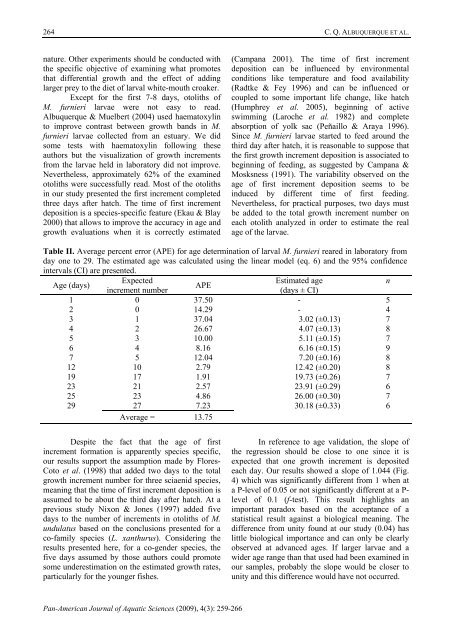Download full issue - PanamJAS
Download full issue - PanamJAS
Download full issue - PanamJAS
Create successful ePaper yourself
Turn your PDF publications into a flip-book with our unique Google optimized e-Paper software.
264<br />
C. Q. ALBUQUERQUE ET AL.<br />
nature. Other experiments should be conducted with<br />
the specific objective of examining what promotes<br />
that differential growth and the effect of adding<br />
larger prey to the diet of larval white-mouth croaker.<br />
Except for the first 7-8 days, otoliths of<br />
M. furnieri larvae were not easy to read.<br />
Albuquerque & Muelbert (2004) used haematoxylin<br />
to improve contrast between growth bands in M.<br />
furnieri larvae collected from an estuary. We did<br />
some tests with haematoxylin following these<br />
authors but the visualization of growth increments<br />
from the larvae held in laboratory did not improve.<br />
Nevertheless, approximately 62% of the examined<br />
otoliths were success<strong>full</strong>y read. Most of the otoliths<br />
in our study presented the first increment completed<br />
three days after hatch. The time of first increment<br />
deposition is a species-specific feature (Ekau & Blay<br />
2000) that allows to improve the accuracy in age and<br />
growth evaluations when it is correctly estimated<br />
(Campana 2001). The time of first increment<br />
deposition can be influenced by environmental<br />
conditions like temperature and food availability<br />
(Radtke & Fey 1996) and can be influenced or<br />
coupled to some important life change, like hatch<br />
(Humphrey et al. 2005), beginning of active<br />
swimming (Laroche et al. 1982) and complete<br />
absorption of yolk sac (Peñaillo & Araya 1996).<br />
Since M. furnieri larvae started to feed around the<br />
third day after hatch, it is reasonable to suppose that<br />
the first growth increment deposition is associated to<br />
beginning of feeding, as suggested by Campana &<br />
Mosksness (1991). The variability observed on the<br />
age of first increment deposition seems to be<br />
induced by different time of first feeding.<br />
Nevertheless, for practical purposes, two days must<br />
be added to the total growth increment number on<br />
each otolith analyzed in order to estimate the real<br />
age of the larvae.<br />
Table II. Average percent error (APE) for age determination of larval M. furnieri reared in laboratory from<br />
day one to 29. The estimated age was calculated using the linear model (eq. 6) and the 95% confidence<br />
intervals (CI) are presented.<br />
Age (days)<br />
Expected<br />
Estimated age<br />
n<br />
APE<br />
increment number<br />
(days ± CI)<br />
1 0 37.50 - 5<br />
2 0 14.29 - 4<br />
3 1 37.04 3.02 (±0.13) 7<br />
4 2 26.67 4.07 (±0.13) 8<br />
5 3 10.00 5.11 (±0.15) 7<br />
6 4 8.16 6.16 (±0.15) 9<br />
7 5 12.04 7.20 (±0.16) 8<br />
12 10 2.79 12.42 (±0.20) 8<br />
19 17 1.91 19.73 (±0.26) 7<br />
23 21 2.57 23.91 (±0.29) 6<br />
25 23 4.86 26.00 (±0.30) 7<br />
29 27 7.23 30.18 (±0.33) 6<br />
Average = 13.75<br />
Despite the fact that the age of first<br />
increment formation is apparently species specific,<br />
our results support the assumption made by Flores-<br />
Coto et al. (1998) that added two days to the total<br />
growth increment number for three sciaenid species,<br />
meaning that the time of first increment deposition is<br />
assumed to be about the third day after hatch. At a<br />
previous study Nixon & Jones (1997) added five<br />
days to the number of increments in otoliths of M.<br />
undulatus based on the conclusions presented for a<br />
co-family species (L. xanthurus). Considering the<br />
results presented here, for a co-gender species, the<br />
five days assumed by those authors could promote<br />
some underestimation on the estimated growth rates,<br />
particularly for the younger fishes.<br />
In reference to age validation, the slope of<br />
the regression should be close to one since it is<br />
expected that one growth increment is deposited<br />
each day. Our results showed a slope of 1.044 (Fig.<br />
4) which was significantly different from 1 when at<br />
a P-level of 0.05 or not significantly different at a P-<br />
level of 0.1 (f-test). This result highlights an<br />
important paradox based on the acceptance of a<br />
statistical result against a biological meaning. The<br />
difference from unity found at our study (0.04) has<br />
little biological importance and can only be clearly<br />
observed at advanced ages. If larger larvae and a<br />
wider age range than that used had been examined in<br />
our samples, probably the slope would be closer to<br />
unity and this difference would have not occurred.<br />
Pan-American Journal of Aquatic Sciences (2009), 4(3): 259-266
















